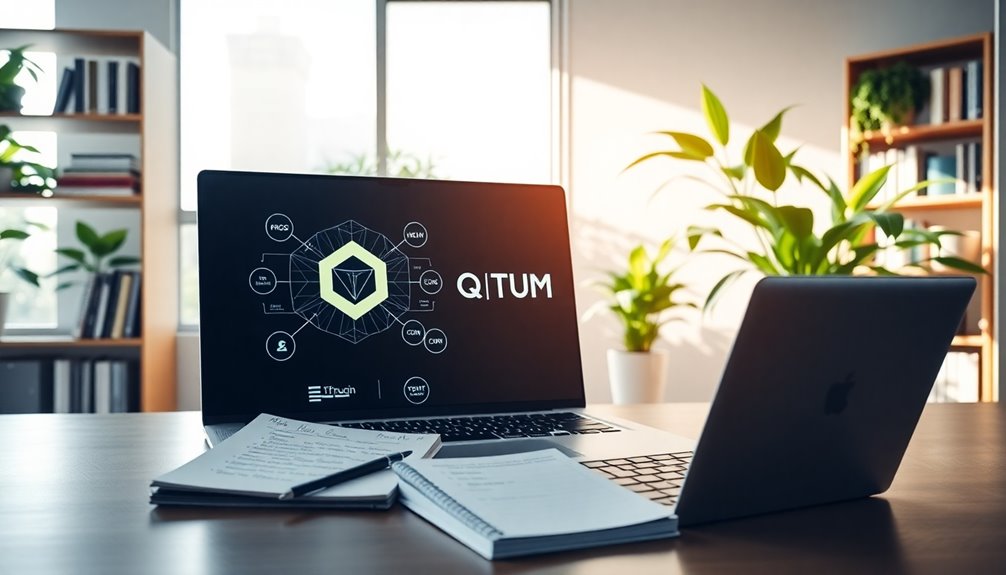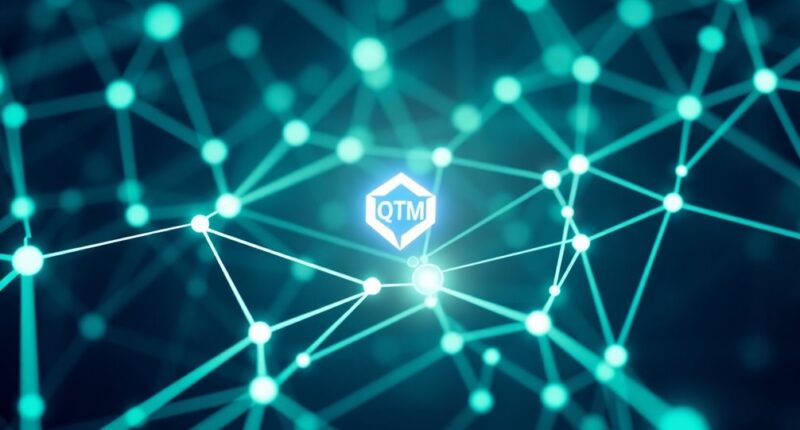QTUM is an innovative hybrid blockchain that combines elements of Bitcoin and Ethereum to enhance functionality and security. It uses Bitcoin's UTXO model for transaction safety and Ethereum's smart contract abilities, handling up to 1,100 transactions per second. With its Account Abstraction Layer, it bridges different models for seamless interaction. QTUM facilitates decentralized applications and business solutions while employing a Proof-of-Stake consensus for efficient validation. Its hybrid governance structure invites community involvement, promoting transparency. Explore further to discover more about QTUM's unique features, advantages, and challenges!
Key Takeaways
- Qtum is a hybrid blockchain platform combining Bitcoin's UTXO model for transaction security with Ethereum's smart contract functionality.
- It supports smart contracts written in Solidity, enabling diverse application development on its network.
- Qtum's Proof-of-Stake consensus mechanism ensures efficient transaction validation and energy efficiency.
- The platform incorporates a hybrid governance model allowing community participation in decision-making and proposal voting.
- Future prospects include increased enterprise adoption and ongoing development for enhanced scalability and regulatory compliance.
Core Concepts of QTUM

When you plunge into QTUM, you'll quickly notice its unique hybrid architecture that combines the best features of Bitcoin and Ethereum.
It utilizes the Unspent Transaction Output (UTXO) model for transaction security while supporting Ethereum's smart contract functionality through the Ethereum Virtual Machine (EVM).
The Account Abstraction Layer (AAL) bridges these two models, enhancing compatibility. QTUM's customized Bitcoin Core codebase adds security and flexibility, making it stand out.
This setup allows for efficient execution of decentralized applications (dApps) and fosters blockchain interoperability. Additionally, QTUM achieves scalability with approximately 1,100 transactions per second, surpassing Ethereum's limits.
Overview of Qtum's Features

As you explore Qtum, you'll discover a range of features that set it apart in the blockchain landscape. Its hybrid blockchain architecture combines Bitcoin's UTXO model with Ethereum's smart contract capabilities, utilizing a Proof-of-Stake consensus for efficient operations. The unique design model of Qtum, which merges Bitcoin's UTXO and Ethereum's smart contracts, enhances its versatility for developers and users alike. The Account Abstraction Layer guarantees seamless interaction between these models. You'll appreciate its support for decentralized applications (dApps), which enhances flexibility and reliability in transactions.
With decentralized governance, the community influences key parameters, fostering a customizable ecosystem. Additionally, Qtum's native coin is integral for transactions and governance, while promising use cases span IoT, DeFi, and decentralized exchanges.
Smart Contracts on Multiple Chains

Qtum's innovative approach to smart contracts extends beyond its own blockchain, making it a versatile option for developers.
By supporting the Ethereum Virtual Machine (EVM), you can easily write smart contracts in Solidity and deploy them on the Qtum network. Its Smart Contract Execution Layer guarantees seamless execution of Ethereum contracts on Qtum.
Plus, with the Cross-Chain Proof-of-Stake consensus mechanism, you can interact with multiple blockchains, enhancing cross-chain compatibility. Additionally, Qtum's unique hybrid architecture combines Bitcoin's UTXO model with Ethereum's capabilities, providing developers with a robust framework for building applications.
Qtum is also developing a Cross-Chain Contract Protocol, enabling smart contracts to communicate across different networks. This allows for seamless data sharing and integration, making it easier to build decentralized applications that leverage multiple blockchain ecosystems.
With these tools, your development process becomes more efficient and interconnected.
Pros and Cons Overview

While exploring the pros and cons of Qtum, you'll find a mix of strengths and weaknesses that can impact your decision to adopt this platform.
On the plus side, Qtum offers fast transaction times, high throughput, and energy-efficient Proof of Stake consensus, along with low gas costs and a decentralized governance model that enhances flexibility. Additionally, the platform's integration of Bitcoin's Taproot facilitates improved UTXO model development.
However, there are downsides to take into account. The infinite incremental scalability might threaten long-term stability, and security risks are associated with using Solidity for smart contracts.
Additionally, the lack of a minimum staking amount could allow malicious actors to exploit the network, while deficiencies in the UTXO model may lead to inaccuracies in smart contracts.
Balancing these factors is essential for informed decision-making.
Versus Ethereum and Bitcoin

When comparing Qtum with Ethereum and Bitcoin, you'll find that each platform has distinct characteristics that cater to different needs.
Qtum's hybrid blockchain model integrates Bitcoin's UTXO model with Ethereum's EVM, enabling smart contracts while maintaining Bitcoin's security. You'll notice faster transaction speeds with Qtum, thanks to reduced block spacing and lower fees—making it more attractive for decentralized applications. The platform employs a Proof of Stake consensus mechanism, which is more energy-efficient than Bitcoin's Proof-of-Work, simplifying the mining process. Additionally, Qtum supports interoperability with various blockchain networks, encouraging Ethereum developers to explore its ecosystem.
This flexibility and compatibility with popular programming languages enhance Qtum's appeal, particularly in the sectors of DeFi and IoT applications.
Regulatory Uncertainties Impacting Adoption

Steering through the regulatory landscape can be intimidating for anyone interested in adopting blockchain technologies like Qtum.
With diverse regulations across jurisdictions, you'll face compliance challenges that demand a solid understanding of local laws. Each region has its own requirements for cryptocurrencies, token offerings, and smart contracts, complicating global operations.
Additionally, you must navigate Know Your Customer (KYC) and Anti-Money Laundering (AML) measures, which are essential to prevent illegal activities.
Token classification under securities regulations is another hurdle, as you'll need to determine if your token qualifies as a security, which can involve stringent registration and disclosure obligations.
Finally, data privacy concerns require adherence to regulations like GDPR, ensuring personal data protection while maintaining user trust.
Growing DeFi Integration

Maneuvering regulatory uncertainties can be intimidating, but the growing integration of decentralized finance (DeFi) within the Qtum ecosystem presents exciting opportunities.
With its Ethereum Virtual Machine (EVM) compatibility, you can easily migrate DeFi applications from Ethereum without incurring additional costs. Qtum supports essential development tools like Truffle and MetaMask, ensuring a smooth experience for developers.
The platform boasts higher transaction speeds and lower fees, making it ideal for high-frequency DeFi applications. Additionally, the Phantom Protocol enhances privacy and security, allowing you to conduct transactions discreetly.
With stablecoins like QuickCash and decentralized exchanges like QiSwap, Qtum offers a robust environment for DeFi innovation, empowering you to explore new financial avenues in a decentralized world. Furthermore, Qtum's proof-of-stake consensus mechanism incentivizes users to participate in securing the network while contributing to the overall ecosystem's stability.
Utilize Qtum's Governance Model

In the dynamic world of blockchain, understanding and utilizing Qtum's governance model can empower you to have a say in the platform's future.
Qtum's Decentralized Governance Protocol (DGP) enables on-chain governance through smart contracts, allowing you to participate in decision-making alongside developers, miners, and community representatives. You can submit proposals for changes, which the community votes on, ensuring your voice matters. Additionally, this governance model supports decentralized governance, allowing for effective decision-making within the ecosystem.
With a hybrid approach, Qtum combines on-chain and off-chain governance, promoting transparency and fairness.
As a community member, you can engage in proposal voting and support initiatives that align with your interests. By actively participating, you contribute to the continuous improvement of the Qtum ecosystem, helping shape its direction and ensuring it meets the needs of its users.
Frequently Asked Questions
How Can I Buy QTUM Tokens?
To buy QTUM tokens, start by choosing a reputable cryptocurrency exchange that supports QTUM.
Create an account by providing your personal information and verifying your identity.
Fund your account using a preferred payment method, then navigate to the QTUM market.
Enter the amount you want to purchase, review the transaction details, and confirm your purchase.
Keep track of your transaction receipt for future reference.
Happy trading!
What Wallets Support QTUM Storage?
Finding a wallet for QTUM storage is like searching for a diamond in a sea of pebbles!
You've got options: the official Qtum Core Wallet offers security and user-friendly management, while third-party wallets provide multi-chain support and customizable settings.
Don't overlook hardware wallets for enhanced security, or software wallets for ease of use and dApp integration.
Mobile wallets are also a great choice if you want to manage your tokens on the go!
Is QTUM a Proof-Of-Stake or Proof-Of-Work Blockchain?
QTUM isn't purely a Proof-of-Stake or Proof-of-Work blockchain; it combines both through its unique Mutualized Proof-of-Stake (MPoS) mechanism.
You'll find that this approach enhances decentralization and lowers hardware demands, making it more accessible. Instead of mining, you can stake your tokens to validate transactions.
This hybrid system not only boosts energy efficiency but also improves scalability, providing a more secure and efficient platform for smart contracts and transactions.
Can QTUM Be Staked for Rewards?
Imagine your QTUM tokens as seeds planted in a fertile garden, ready to grow into rewards. Yes, you can stake QTUM for rewards! By locking up your tokens, you'll help validate transactions and earn block rewards, plus transaction fees.
You'll need a QTUM Core wallet and mature UTXOs to start. As your tokens flourish, expect rewards within 7 to 25 days, making your investment bloom with potential returns. Happy staking!
What Is the Total Supply of QTUM Tokens?
The total supply of QTUM tokens is capped at approximately 107.8 million coins. Initially, 100 million were distributed, with 51% sold during the 2017 crowdsale.
The circulating supply currently sits around 105.5 million, increasing gradually through marketing funds and staking rewards.
Over time, block rewards will halve, eventually reaching zero by 2045. This distribution guarantees that the token economy remains functional and incentivizes participation in the network.
Conclusion
In the rapidly evolving world of blockchain, Qtum stands out as a bridge between the best of Bitcoin and Ethereum, offering you a unique blend of security and flexibility. But as you explore this hybrid blockchain, consider the potential it holds for the future of decentralized applications and finance. While regulatory hurdles loom, the promise of innovation and community-driven governance could redefine your relationship with technology, making it a compelling journey worth your attention.









